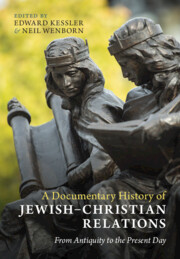Book contents
- Frontmatter
- Dedication
- Contents
- Contributors
- Editors’ Preface
- Acknowledgements
- Abbreviations of Rabbinic Literature and Scripture
- Documents
- Introduction
- Part I To 900 ce
- Part II 900 to 1800
- 4 The Medieval Period
- 5 From the Reformation to the Enlightenment
- Part III 1800 to the Present Day
- Index of Documents and Sources
- Index of Names and Subjects
- References
4 - The Medieval Period
The Tenth to the Fifteenth Century
from Part II - 900 to 1800
Published online by Cambridge University Press: aN Invalid Date NaN
- Frontmatter
- Dedication
- Contents
- Contributors
- Editors’ Preface
- Acknowledgements
- Abbreviations of Rabbinic Literature and Scripture
- Documents
- Introduction
- Part I To 900 ce
- Part II 900 to 1800
- 4 The Medieval Period
- 5 From the Reformation to the Enlightenment
- Part III 1800 to the Present Day
- Index of Documents and Sources
- Index of Names and Subjects
- References
Summary
This chapter witnesses the Crusades and forced conversions of Jews, disputations and expulsions, as well as blood libel charges. Even though Jews also disparaged Christianity, viewing it as idolatry, there were also periods of relatively easy Jewish–Christian coexistence, such as in Spain.
- Type
- Chapter
- Information
- A Documentary History of Jewish–Christian RelationsFrom Antiquity to the Present Day, pp. 185 - 232Publisher: Cambridge University PressPrint publication year: 2024

